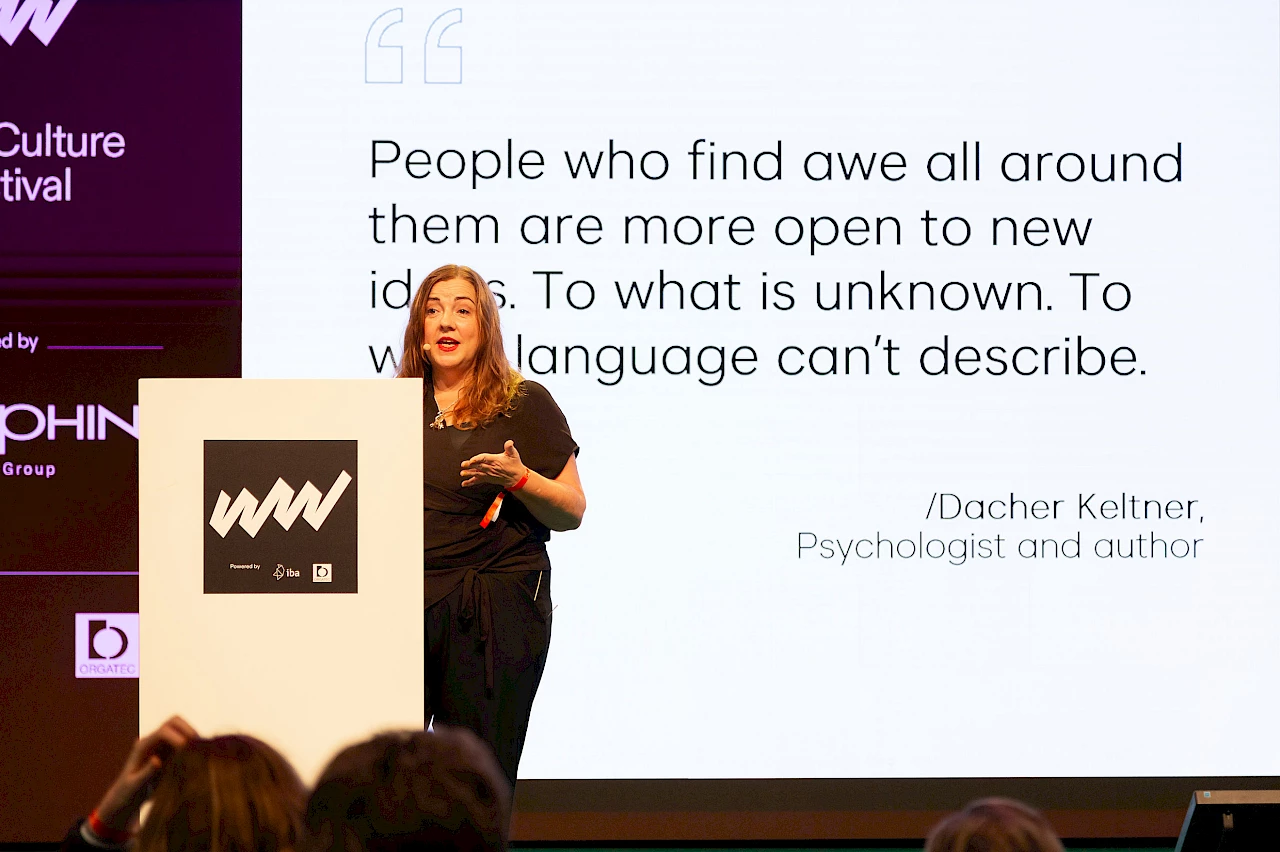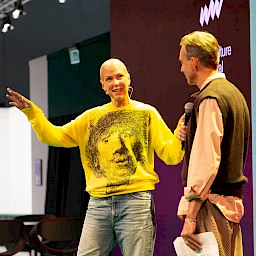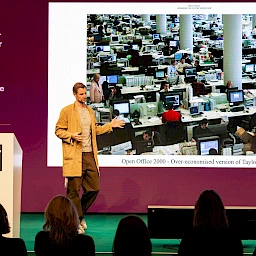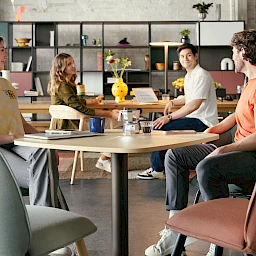How do you measure the quality of an office? The most important metric used to be efficiency, which addressed factors such as workstations per square metre, costs per employee, and productivity per hour. However, Marie Stafford, Global Director of VML Intelligence, is calling for a radical change of perspective. In her presentation at the Work Culture Festival, she outlined the future of the world of work — a future where emotional quality takes centre stage. Her vision is of companies that specifically design emotions in order to create a working environment that inspires, connects and motivates.
„Emotion gap“ and the yearning for experiences
Stafford began her presentation with sobering findings: “Most workstations are purely functional. They’re places of efficiency, not inspiration.” People long for emotional experiences, but they are finding them less and less in everyday life. Stafford refers to it as “emotion gap”. By this she means a growing gap between the desire for meaningful, moving moments and the often grey and monotonous reality. To take one example, a VML study showed that two thirds of respondents reported that they felt like they were “in the waiting room of life”. Crises, the rising cost of living, global conflicts and mental stress are shaping our sense of time. According to Stafford, this is precisely why the workplace is a place where joy and meaningfulness should be cultivated. “Work makes up a third of our lives. It would be absurd to spend this time without any emotion.”
Emotioneering — a new perspective on work
The term is inspired by Disney’s Imagineering and describes the conscious design of experiences with emotional added value. The question is not only what tasks a room makes possible, but above all what feelings it triggers. Emotions are not something secondary. They increase creativity, promote resilience and influence whether employees identify with a company in the long term. Stafford emphasised that the classic focus on efficiency and functionality is no longer sufficient. “We need to develop workplaces that not only allow the entire spectrum of human emotions, but actively stimulate them.”
The five pillars of emotioneering
In her presentation, Stafford presented five key aspects that can be used to consciously shape emotions.
1. Awe:
Awe arises when something seems bigger, more beautiful or more meaningful than expected, which broadens our perspective. Stafford compared this phenomenon to the “overview effect” that astronauts experience when they see the earth from space. Similar moments could be created in offices through unusual architecture, inspiring works of art or the use of nature. According to Stafford, awe reduces stress and promotes connection with others. It makes us more cooperative and open-minded.
2. Joy and playfulness:
Joy in the workplace is not a luxury, but a driver of creativity and productivity. Stafford spoke of the “joy economy”, in which playful elements, bright colours or unexpected design accents are not considered a distraction, but a source of innovation. Examples such as the “dopamine interiors” concept from IKEA or playful room designs show how conscious design can lift the mood. Stafford summarized it so: “Fun is often underestimated, but it boosts creativity and fosters cooperation.”
3. Surprise and magic:
Surprises spark curiosity and break through routines. Stafford cited examples from the retail sector, such as the Korean eyewear label Gentle Monster, whose stores look like art installations. Applied to the world of work this could, for example, mean: Flexibly adapting space concepts, unconventional details or interactive elements that continually generate new experiences. “The brain reacts particularly strongly to the unexpected. Surprises are a driver of innovation.”
4. Connection and community:
According to Stafford, one of the biggest shortcomings of today’s working environments is the loss of a sense of community, which is reinforced by remote work and hybrid models. “A sense of belonging is a basic need, just as important as food or water.” Emotioneering promotes encounters through communicative room design, shared rituals (e.g. lunch together) or employee resource groups that facilitate exchange. Digital tools can also help strengthen social ties.
5. Calm and serenity:
In addition to highs, the world of work also needs moments of calm and relaxation. Stafford pointed out that about a third of our work requires a high level of concentration. Noise and constant communication are counterproductive. “Calm is also a matter of inclusion. Neurodivergent people in particular need spaces to retreat to.” She recommended analogue zones, rooms without telephones and the targeted use of soundscapes to promote calm and focus.
Emotions as a strategic success factor
Stafford argued that emotions are not a soft issue, but a hard competitive factor. Companies that invest in the emotional qualities of their workspaces benefit in two ways: On the one hand, they increase employee satisfaction and loyalty; on the other, they create an environment that favours innovation. “Employees who feel inspired and like they belong are more creative, more motivated and stay with the company longer,” she emphasised. The added value of emotions can also be demonstrated economically. Studies show that people spend more time in rooms that evoke positive emotions. An workplace with an emotionally charge can reduce staff turnover, prevent burnout and increase company value as it is perceived as more attractive — both by employees and potential talent. Stafford therefore advocated integrating emotional indicators such as the level of perceived joy, awe or connectedness into employer branding and workplace design.
Outlook: rethinking work culture
The ideas of emotioneering show that the future of work will not only be shaped by technologies and processes, but also by the ability to understand and shape human emotions. Stafford urged companies to try small steps: “It’s not always a matter of major restructuring measures. Even a small element, be it an inspiring eye-catcher, a creative lunch break or a quiet space, can have a big impact.” It remains to be seen whether emotioneering will establish itself as a standard in workplace design. Yet, it’s clear that emotions in the workplace are no longer a luxury, but an essential element of today’s corporate culture.
Marie Stafford is Global Director of VML Intelligence and an expert in strategic foresight. She analyses global trends at the interface of culture, consumer behaviour and innovation and regularly presents her visions for the future at international conferences. Her assessments have been published in the Financial Times and the New York Times, among others. She is also co-author of the annual VML Future 100 trend report. Further information is available at: vml.com
Cover photo: @ IBA







